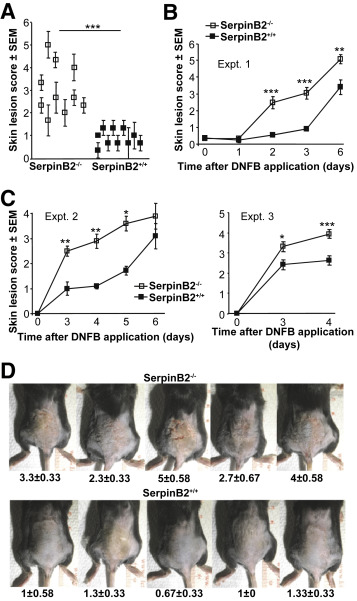SerpinB2 Deficiency Results in a Stratum Corneum Defect and Increased Sensitivity to Topically Applied Inflammatory Agents.
SerpinB2 (plasminogen activator inhibitor type 2) is constitutively expressed at high levels by differentiating keratinocytes in mice and humans; however, the physiological function of keratinocyte SerpinB2 remains unclear. Herein, we show that SerpinB2(-/-) mice are more susceptible to contact dermatitis after topical application of dinitrofluorobenzene, and show enhanced inflammatory lesions after topical applications of phorbol ester. Untreated SerpinB2(-/-) mice showed no overt changes in epithelial structure, and we were unable to find evidence for a role for keratinocyte SerpinB2 in regulating immunity, apoptosis, IL-1β production, proteasomal activity, or wound healing. Instead, the phenotype was associated with impaired skin barrier function and a defective stratum corneum, with SerpinB2(-/-) mice showing increased transepidermal water loss, increased overt loss of stratum corneum in inflammatory lesions, and impaired stratum corneum thickening after phorbol ester treatment. Immunoblotting suggested that SerpinB2 (cross-linked into the cornified envelope) is present in the stratum corneum and retains the ability to form covalent inhibitory complexes with urokinase. Data suggest that the function of keratinocyte SerpinB2 is protection of the stratum corneum from proteolysis via inhibition of urokinase, thereby maintaining the integrity and barrier function of the stratum corneum, particularly during times of skin inflammation. Implications for studies involving genetically modified mice treated with topical agents and human dermatological conditions, such as contact dermatitis, are discussed.
Authors
Wayne A Schroder; Itaru Anraku; Thuy T Le; Thiago D C Hirata; Helder I Nakaya; Lee Major; Jonathan J Ellis; Andreas Suhrbier
External link
Publication Year
Publication Journal
Associeted Project
Microbiology or Immunology
Lista de serviços
-
StructRNAfinder: an automated pipeline and web server for RNA families prediction.StructRNAfinder: an automated pipeline and web server for RNA families prediction.
-
CEMiTool: a Bioconductor package for performing comprehensive modular co-expression analyses.CEMiTool: a Bioconductor package for performing comprehensive modular co-expression analyses.
-
webCEMiTool: Co-expression Modular Analysis Made Easy.webCEMiTool: Co-expression Modular Analysis Made Easy.
-
Assessing the Impact of Sample Heterogeneity on Transcriptome Analysis of Human Diseases Using MDP Webtool.Assessing the Impact of Sample Heterogeneity on Transcriptome Analysis of Human Diseases Using MDP Webtool.
-
Predicting RNA Families in Nucleotide Sequences Using StructRNAfinder.Predicting RNA Families in Nucleotide Sequences Using StructRNAfinder.
-
OUTBREAK: a user-friendly georeferencing online tool for disease surveillance.OUTBREAK: a user-friendly georeferencing online tool for disease surveillance.
-
Noninvasive prenatal paternity determination using microhaplotypes: a pilot study.Noninvasive prenatal paternity determination using microhaplotypes: a pilot study.
-
Editorial: User-Friendly Tools Applied to Genetics or Systems Biology.Editorial: User-Friendly Tools Applied to Genetics or Systems Biology.
-
Automatic detection of the parasite Trypanosoma cruzi in blood smears using a machine learning approach applied to mobile phone imagesAutomatic detection of the parasite Trypanosoma cruzi in blood smears using a machine learning approach applied to mobile phone images
-
Tucuxi-BLAST: Enabling fast and accurate record linkage of large-scale health-related administrative databases through a DNA-encoded approachTucuxi-BLAST: Enabling fast and accurate record linkage of large-scale health-related administrative databases through a DNA-encoded approach
-
Ten quick tips for harnessing the power of ChatGPT in computational biologyTen quick tips for harnessing the power of ChatGPT in computational biology

